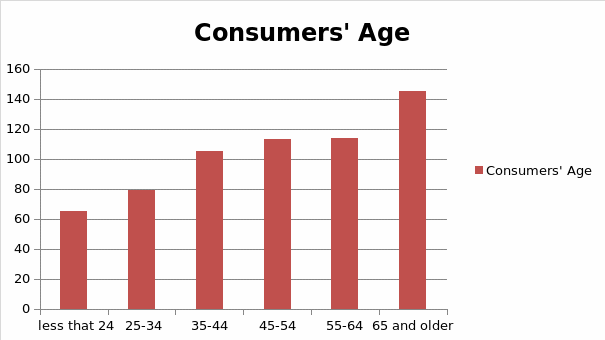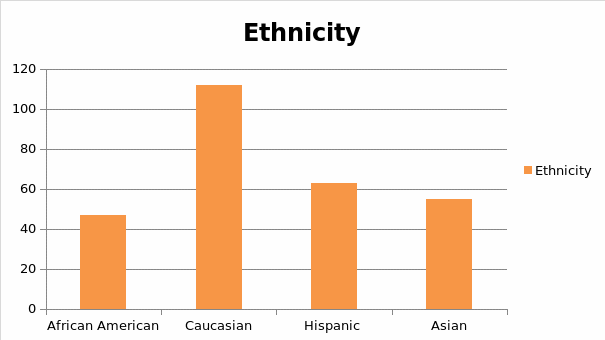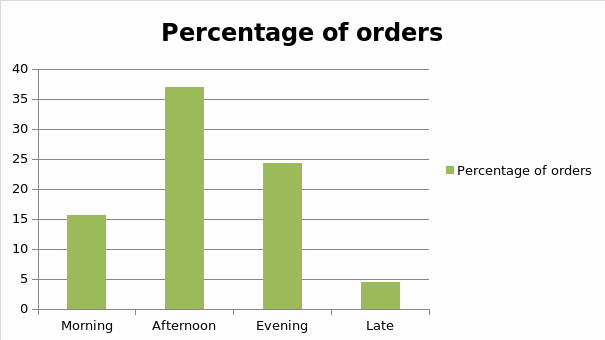Segmentation and Targeting
Dunkin’ Donuts has been on the market for about six decades. Its brands and targeting strategies are designed to evolve along with the changing demands and tastes of its consumer segment. Currently, the consumer segment of Dunkin’ Donuts has a number of different characteristics. For example, the majority of Dunkin’ Donuts consumers are the individuals of senior age (see fig. 1), Caucasian background (see fig. 2), with a higher education, and a higher level of income (“Dunkin Donuts Consumer Insights”). Moreover, statistically, they prefer to purchase their favored products in the afternoon (see fig. 3) in larger amounts (21 or more items per one purchase) (“Dunkin Donuts Consumer Insights”).
Due to the prevalence of senior customers, Dunkin’ Donuts has a strong customer engagement strategy that is directed at targeting younger consumers. Some of the strategies involve the introduction of Apple Pay option to the services of the franchise, bonus and perk systems, leveraging the use of technology in order to strengthen the brand experience, special offers, and the engagement and maintenance of multiple digital channels (Fuqua and Hudler).
In addition, since according to the data of the previous years, the performance of Dunkin’ Donuts brands, especially their coffee, was the strongest in the morning, the managers of the franchise decided to change the consumer dynamics and leverage their daytime opportunities. For that purpose, a special program was created offering perks to the consumers who make a purchase in the afternoon (Fuqua and Hudler). As a result, the afternoon purchases grew significantly.
Positioning
Dunkin’ Brands includes several items whose differentiation is one of the main positioning strategies of the company. To be more precise, currently, coffee is one of the most commonly purchased products of the brand; however, this does not mean that the company is planning to de-emphasize its donuts because the differentiated specialization is much more profitable for the brand from the positioning perspective (Yohn).
Also, in order to differentiate itself from the consumers, Dunkin’ Brands is focused on the expansion of its product lines and offering a more diverse menu in order to attract the consumers with versatile needs (Trefis Team). Practically, instead of focusing on sole merchandise, the company is launching many diverse product lines for the purpose of growing their customer base and becoming relevant to customers with different tastes.
In addition, in order to promote their brands and products, Dunkin’ Brands have embraced a variety of digital means for marketing. In particular, the newly engaged On-the-Go system allows the customers of Dunkin’ Brands to make online orders of the desired products using the specialized app. Another digital initiative from Dunkin’ Brands is DD Perks; this program currently has a large consumer base of over six million people (Trefis Team).
The main purpose of this program is to attract a younger base of consumers who are the frequent users of digital technologies and engage them by means of offering perks for purchases. Finally, streamlined menu lines are introduced to several hundreds of Dunkin’ Brands shops optimizing the working process of the employees, reducing staff turnover, and improving the service quality.
Appendices



Works Cited
“Dunkin Donuts Consumer Insights.” InfoScout, 2015. Web.
Fuqua, Chris and Scott Hudler. “Dunkin’ Donuts U. S. Marketing.” Investor Day Marketing, 2014. Web.
Trefis Team. “Examining Dunkin’ Brands’ Growth Strategy.” Forbes. 2017.
Yohn, Denise Lee. “Dunkin’ Donuts Should Embrace Its Differentiation.” Forbes. 2017.